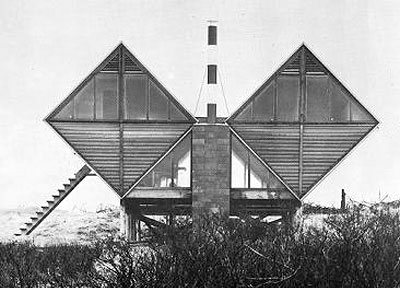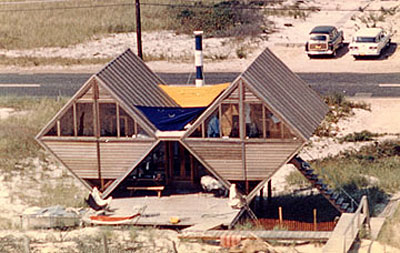Diamond Brassiere

At what point did a vacation home become a second home? Complete with hi-speed internet, washer/dryer capable of handling 19 pairs of jeans and a gas grill normally used by restaurants, staying connected has replaced the traditional vacation theme of getting away. This reminds me of how very little is needed to stray from everyday life.
Vacation homes and specifically beach houses may be one of the few times Modernism actually got it right. Often difficult to actually live and work in, modern buildings have the suspicious habit of looking better than performing.
To enjoy the beach doesn't really require much. Somewhere to lie, somewhere to change and somewhere to keep food satisfy most of the basic needs (with bathrooming easily accomplished pirate style). I'm willing to be naive and simplify the function of a truly successful beach house to do just these things.
The Pearlroth House in Westahampton, NY is a success. Made up of a wooden deck, two living pods and connected by a great room with a view, the design has sparcely little excess. I like how it contains all the parts but still ask the question "Can anyone actually live in that thing?" Built in 1958 and just 600 sf, this cottage has met the vacationing needs of the Pearlroth family for almost 50 years.

Designed by Andrew Geller (a one time chief architectural designer for Raymond Loewy Associates) as what would now be termed a freelance project, a low budget and a difficult site weren't prohibitive constraints. Geller's primary understanding of function and liberated sense of whimsy produced a building that I think now is largely impossible.
On May 15, 2005, this icon is slated to be destroyed to make room for a larger and I'm sure less remarkable model. A concerted campaign has been mounted to move and restore the house before its demise. For the sake of preserving good architectural role models I hope the building is not lost.
images by archINFORM and explodedview.tv
